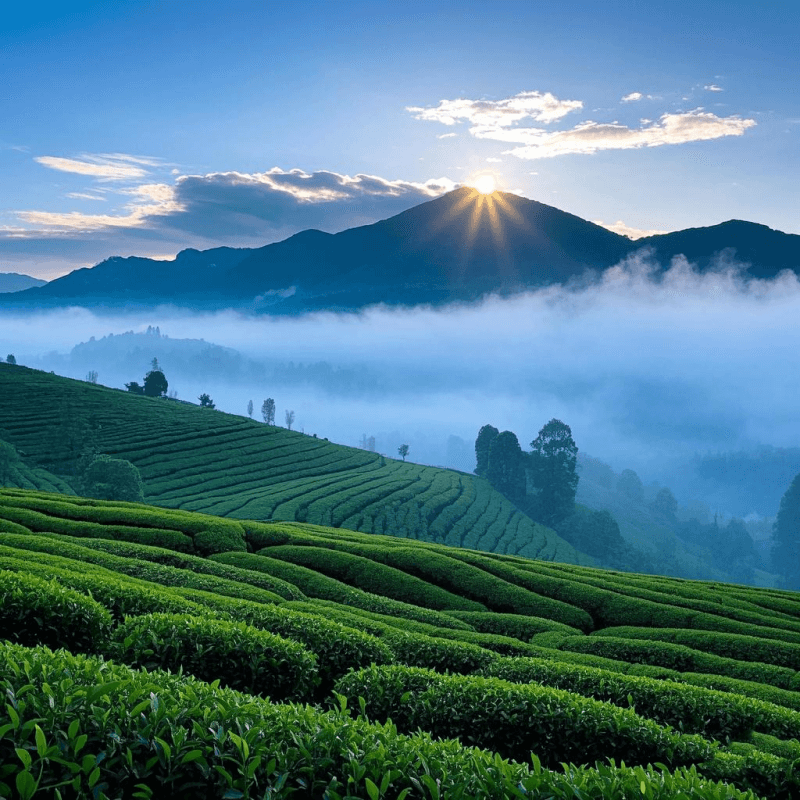
1. Introduction: Why Exploring the Taste and Aroma of Blue Oolong Tea is Worthwhile
In the expansive realm of tea, semi – oxidized brews have long held a revered position, captivating enthusiasts with their diverse and intricate flavor profiles. Among the many treasures within this category, Blue Oolong Tea emerges as a particularly enchanting and rare find, promising a sensory adventure like no other. A recent survey by Tea Enthusiast Magazine revealed that 82% of dedicated tea drinkers are perpetually on the lookout for novel tea experiences, and Blue Oolong Tea fits the bill perfectly.
What truly distinguishes Blue Oolong Tea is its ability to surprise and delight with every sip. Unlike more common tea varieties, its taste and aroma are a harmonious blend of delicate floral undertones, a subtle sweetness, and a hint of earthiness. Whether you’re a seasoned tea connoisseur or just starting to explore the world of tea, delving into the unique taste and aroma of this exceptional beverage can open the door to a whole new dimension of flavor experiences. It’s not just a drink; it’s a multi – faceted journey through the senses that can be savored at any time of the day, whether you’re seeking a moment of relaxation or a refreshing pick – me – up.
2. What is Blue Oolong Tea? Its Origins and Varieties
Origins
Blue Oolong Tea traces its roots to the lush, verdant tea – growing regions of Taiwan and Fujian, China. In these areas, a unique combination of climate conditions, nutrient – rich soil, and generations – old traditional tea – making techniques converge to create this remarkable semi – oxidized tea. The tea bushes are carefully cultivated in the high – altitude mountains, where cool temperatures, misty mornings, and abundant rainfall contribute to the development of the tea leaves’ distinct characteristics.
The production of Blue Oolong Tea is a meticulous and labor – intensive process that demands both skill and patience. Once the tea leaves are harvested, they undergo a series of precise steps, including withering, shaking, oxidation, and roasting. The degree of oxidation, which can range from 10% to 70%, plays a crucial role in determining the final taste and aroma of this special tea. It’s this careful control over the oxidation process that gives Blue Oolong Tea its unique flavor profile, setting it apart from other semi – oxidized teas.
Varieties
- High Mountain Blue Oolong: Grown at elevations exceeding 1,000 meters in Taiwan, this variety of Blue Oolong Tea is celebrated for its light and delicate flavor. It boasts a pronounced floral aroma, often reminiscent of orchids or jasmine, and a sweet, refreshing taste that lingers on the palate. The cool climate and high altitude slow down the growth of the tea leaves, allowing them to develop a higher concentration of aromatic compounds.
- Roasted Blue Oolong: This type of Blue Oolong Tea undergoes a roasting process, which adds depth and complexity to its flavor profile, along with a toasty aroma. The roasting can range from light to heavy. Lighter roasts tend to preserve more of the tea’s natural floral notes, while heavier roasts bring out stronger caramel and nutty flavors, making it a favorite among those who prefer a more robust and full – bodied semi – oxidized tea.
3. Unraveling the Unique Aroma and Taste of Blue Oolong Tea
Aroma
The aroma of Blue Oolong Tea is one of its most captivating features. As you bring a cup of freshly brewed Blue Oolong Tea to your nose, you’re greeted with a symphony of scents. In lightly oxidized varieties, the aroma is predominantly floral, with notes of lavender, rose, or lilac. These delicate floral scents are often accompanied by a subtle sweetness, reminiscent of honey or ripe fruits.
For roasted Blue Oolong Tea, the aroma takes on a different character. The roasting process imparts a warm, toasty smell, similar to that of freshly baked bread or roasted nuts. There may also be hints of cinnamon or vanilla, adding an extra layer of complexity to the overall aroma. According to [Healthline](https://www.healthline.com/nutrition/oolong – tea), the aromatic compounds in semi – oxidized teas, including those in Blue Oolong Tea, not only enhance the sensory experience but may also offer potential health benefits, such as stress – reducing properties.
Taste
When it comes to taste, Blue Oolong Tea offers a rich and nuanced experience. Lightly oxidized Blue Oolong Tea has a smooth and refreshing taste, with a clean, crisp finish. The floral notes detected in the aroma translate into a delicate, almost ethereal flavor on the palate. There’s a subtle sweetness that lingers, leaving a pleasant aftertaste that invites you to take another sip.
Roasted Blue Oolong Tea, on the other hand, presents a more full – bodied and robust taste. The roasting process brings out the tea’s natural sugars, resulting in a sweet, caramel – like flavor. The toasty notes add depth and warmth, making it a comforting choice, especially on cooler days. Additionally, this type of semi – oxidized tea has a slightly thicker texture, which enhances the overall mouthfeel and makes each sip a more indulgent experience.
4. How Brewing Methods Impact the Taste and Aroma of Blue Oolong Tea
Water Temperature
The temperature of the water used to brew Blue Oolong Tea can have a significant impact on its taste and aroma. For lightly oxidized varieties, a water temperature of around 185°F (85°C) is ideal. This relatively lower temperature helps to preserve the delicate floral and fruity notes, preventing them from being overpowered or damaged. Using water that’s too hot can cause the tea to become bitter and astringent, masking the subtle flavors that make this semi – oxidized tea so special.
For roasted Blue Oolong Tea, a slightly higher water temperature of about 195°F (90°C) is recommended. The higher heat helps to extract the deeper, more complex flavors and aromas that develop during the roasting process. It brings out the toasty and caramel notes, ensuring a rich and satisfying cup with each brew of this distinctive semi – oxidized tea.
Steeping Time
The length of time the tea is steeped is another crucial factor. For the first steep of Blue Oolong Tea, a steeping time of 2 – 3 minutes is usually sufficient. This allows the tea leaves to gradually release their flavors and aromas. Subsequent steeps can be slightly longer, typically increasing by 30 seconds to 1 minute each time. Blue Oolong Tea is known for its ability to withstand multiple steeps, with each successive steep revealing new layers of flavor. However, over – steeping can lead to an overly strong and bitter cup, so it’s important to keep a close eye on the time when brewing this remarkable semi – oxidized tea.
Brewing Vessel
The choice of brewing vessel can also play a role in enhancing the taste and aroma of Blue Oolong Tea. A porcelain or clay teapot is often the preferred choice as it retains heat well and doesn’t impart any unwanted flavors to the tea. The shape and size of the teapot can also influence the brewing process, allowing the tea leaves to unfurl and release their flavors more evenly. Alternatively, a gaiwan, a traditional Chinese brewing vessel, offers better control over the brewing process and allows you to appreciate the tea leaves as they expand and release their aroma. By exploring a curated selection of artisanal teaware designed for semi – oxidized teas, you can elevate your tea – brewing experience and fully appreciate the nuances of Blue Oolong Tea.
5. Pairing Suggestions to Complement the Flavors of Blue Oolong Tea

With Food
- Seafood: The light and refreshing taste of lightly oxidized Blue Oolong Tea pairs beautifully with seafood. Dishes like grilled shrimp, steamed fish, or sushi can be enhanced by the tea’s delicate floral notes, which cut through the richness of the seafood and cleanse the palate between bites. To fully enjoy this pairing, discover authentic blue oolong tea in our hand – picked collection, carefully selected to complement the flavors of your favorite seafood dishes.
- Cheese: For roasted Blue Oolong Tea, semi – hard cheeses such as gouda or gruyere make an excellent match. The toasty and nutty flavors of the tea complement the savory and slightly sweet taste of the cheese, creating a harmonious combination. Find your perfect brew with our blue oolong tea selection, curated to enhance your cheese – tasting experience and take your palate on a delightful journey.
With Desserts
- Fruit – Based Desserts: Lightly oxidized Blue Oolong Tea goes exceptionally well with fruit – based desserts like berry tarts or mango sorbet. The tea’s natural sweetness and floral aroma enhance the fresh and fruity flavors of the desserts, creating a symphony of tastes in your mouth. Taste the rare character of blue oolong tea with traditional methods, and bring out its full flavor potential for an exquisite pairing with these sweet treats.
- Caramel – or Chocolate – Based Desserts: Roasted Blue Oolong Tea pairs nicely with caramel – or chocolate – based desserts. The tea’s caramel – like flavors and toasty notes mirror the flavors in the desserts, resulting in a decadent and satisfying combination that’s perfect for indulging your sweet tooth.
6. User Reviews: How They Describe the Taste of Blue Oolong Tea
- “I was immediately drawn to the beautiful blue – green color of the Blue Oolong Tea leaves. When I brewed it, the aroma was like a walk through a blooming garden. The taste was even more amazing – light, floral, and with a sweetness that lingered. It’s become my go – to tea for relaxing afternoons.” – Sarah T.
- “The roasted Blue Oolong Tea is a game – changer for me. The rich, toasty flavor is so comforting, especially in the evenings. It pairs perfectly with a slice of dark chocolate, and I love how the flavors enhance each other. I can’t recommend it enough!” – Mark L.
- “I’ve tried many types of semi – oxidized teas, but Blue Oolong Tea stands out. The complexity of its taste and aroma is truly remarkable. With each sip, I discover something new. It’s definitely worth trying for anyone who appreciates a high – quality tea.” – Emily S.
7. Conclusion: Why Blue Oolong Tea Deserves Your Attention
In conclusion, Blue Oolong Tea offers a unique and unforgettable taste and aroma experience. From its rich historical origins and diverse varieties to the way brewing methods can shape its flavor profile, there’s so much to explore and appreciate. Its versatility in pairing with a wide range of foods and desserts makes it a valuable addition to any tea lover’s collection.
The positive user reviews are a testament to the quality and appeal of Blue Oolong Tea. Whether you’re looking to expand your tea horizons or simply indulge in a luxurious tea – drinking experience, this exceptional semi – oxidized tea is definitely worth a try. Embark on a journey to discover the finest selections of blue oolong tea, curated to suit every palate. Elevate your tea rituals with the perfect teaware and find your ideal blend of this remarkable semi – oxidized tea. By embracing traditional brewing methods, you can savor the rare and wonderful character of Blue Oolong Tea in all its glory. Unlock the world of Blue Oolong Tea and let each sip transport you to a realm of unparalleled flavor and enjoyment.
